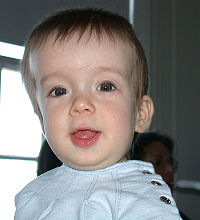
Photo from wikipedia
: A question that remains unanswered is at what level of surgical correction does the public perceive a head shape to be "normal" or "acceptable?" For most cases of non-syndromic… Click to show full abstract
: A question that remains unanswered is at what level of surgical correction does the public perceive a head shape to be "normal" or "acceptable?" For most cases of non-syndromic asymptomatic craniosynostosis, the parents desire for surgical correction is to improve the cosmetic appearance of head shape. At the time of this writing, the intraoperative surgeons' perspective of what constitutes an acceptable head shape is the target for surgical correction. In introducing an improved objectively cosmetic goal, an appropriate outcome measure would be to assess what the general public considers a normal or acceptable head shape in children with craniosynostosis. METHOD Twenty-two unique images were presented via an online crowdsourcing survey of a severe case of non-syndromic sagittal craniosynosis gradually corrected to an age and gender matched normalized head shape. Participants were recruited via the Sick Kids Twitter account. Participants were invited to rate the head shapes as "normal" or "abnormal." RESULTS The 538 participants completed the online survey. Participants were able to reliably and consistently identify normal and abnormal head shapes with a Kappa Score >0.775. Furthermore, participants indicated that a correction of 70% is required in order for the cranial deformity to be regarded as "normal." This threshold closely reflects a normal Cranial Index, which is a widely used morphometric outcome in craniosynostosis. CONCLUSION Crowdsourcing provides an ideal method for capturing the general population's perspective on what constitutes a normal and acceptable head shape in children with sagittal craniosynostosis. Laypersons are able to reliably and consistently distinguish cranial deformities from a "normal" head shape. The public indicates a threshold correction of 70% in sagittal craniosynosis to regard it as a "normal" head shape.
Journal Title: Journal of Craniofacial Surgery
Year Published: 2020
Link to full text (if available)
Share on Social Media: Sign Up to like & get
recommendations!